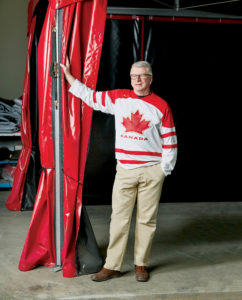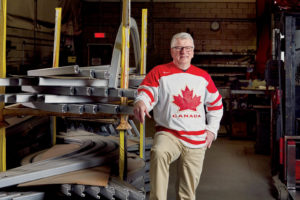
Running a business is hard work. There’s always a time when you’ve got to change the way you’re doing things,” says David Murray, founder and president of Fiesta Tents Ltd. in Saint-Laurent, Quebec, Canada. “Every year you have to review your business—you have to review and correct.”
The inspiration for starting a business came in 1976 while Murray was working with horses at the city park adjacent to the Olympic Stadium during the Olympic Summer Games in Montreal. “When I arrived at the park I saw these two beautiful brand-new white 60-by-150-foot tents. Each one accommodated about 60 box stalls for the Olympic athletes’ horses,” he says. “I had never been beneath a tent that big before. They’re not that big by today’s standards, but back then it was impressive.”
At that time, Murray’s career goals varied from becoming a pilot for the Canadian Armed Forces or commercial airlines to being a professional hockey player. And while he did earn his pilot’s license (he still flies often and plays approximately 100 hockey games a year), it was tenting that captured his professional ambition.
If you build it…
The year following the Olympic Summer Games in Montreal, Murray floated his idea for a business erecting tented box stalls to local ranchers and people involved in the horse show circuit—and the responses were overwhelmingly enthusiastic. “I told them what I had seen at the Olympic Stadium and asked them: If I bought a tent and built some stalls so you could house 60 more horses than you’re able to now, would you be interested?” Murray says. “They said: Absolutely!”
One of those ranchers was so impressed with the idea that he loaned Murray $10,000 to get his idea off the ground. Murray added the investment to what funds he already had—$500. So with a grand total of $10,500, he purchased a 60-by-180-foot used pole tent, organized some friends to help him build 60 box stalls, and launched Portable Stabling (the company that would eventually become Fiesta Tents). “Because of our tents, these little horse shows became bigger and were able to hold 120 horses overnight instead of 60,” he says. “We picked up four or five shows that first year.”
Over the next 10 years, Murray grew the business 50 percent each year, with shows in Montreal, Ottawa, Quebec City and Toronto. He purchased 10 new 60-by-200-foot pole tents and had more than 800 box stalls in inventory. “A bunch of my hockey player and football friends helped me those first years,” he says. “We ate sandwiches, drank beer and slept in a trailer we pulled.”
The perfect R&D
In the mid-1980s, Murray began buying small party tents, expanded into the event market and rebranded the company Fiesta Tents. After buying a couple of clearspan structures for the 1988 Winter Olympics in Calgary, he decided it was time to venture into the design and manufacturing side of the tenting industry. “I felt it was time to build our own line of structures,” Murray says. “I had a great staff, and hired more. It gave me time to hand over the day-to-day side of the rental business and devote myself to R&D and design.”

He began by designing structures for the company’s use, after which he collected comments and feedback from the installation crew. “I call it the perfect R&D,” Murray says. “The rental team would give me their thoughts such as: ‘This takes too long to set up.’ Or: ‘The connection needs work.’ We used that information to work out the bugs and develop a product line—and started selling it in 1992.”
The Fiesta Tents team continues to innovate with new designs, including an ongoing project for what Murray believes will be one of the biggest outdoor performance stages in the world. (See the Snapshot on page 27.) “Innovation design is really a big thing for us,” Murray says. “We’ll do almost any ‘impossible’ design request that comes to us.”
Sharing the load
With accelerated growth comes an increase in demands on leadership. And while Murray is still president and drives the business, he has brought two partners up from within the ranks as part-owners: International sales manager Alexandre Renaud and engineer Richard Castonguay. “As the company grows, it’s impossible to lead alone, so you have to add people,” Murray says. “Alex and Richard have worked with us for a long time and you can’t ask for better experience than they bring to the table. Alex has four sales people under him and knows both manufacturing and rental. And Richard is a certified engineer and helps with design, calculations and oversees installing structures to code. They’re the perfect storm for me—they’re extremely dedicated.”
Murray says it’s been a process letting go of some of the leadership, but it’s been an effort worth making. “It’s a big let-go, but I let them run with it,” he says. “And I’m always here for them if there are any questions or concerns.”
It’s also important to Murray that the rest of his staff has the appropriate authority to do what needs to be done to keep projects moving forward. In the rare instance when the clock’s ticking on a project and the crew needs to put in overtime to meet the deadline, Murray tells his crew chiefs to give the crew concessions to keep them motivated and encouraged. “Let’s say the job is 100 miles away and the crew has worked a full day but you need them to work another two hours to finish. I tell my foremen to give the crew anything they want food- and drink-wise, and comp time as well, to get it done that day,” he says. “I tell them they have the authority to do whatever they need to do to encourage the staff about the importance of their role in the project.”
Friendly competition
It’s not only ingenuity and tenacity that has helped Murray build his thriving tent rental and manufacturing business—he also credits his success to relationships he’s built with competitors and friends in the industry. “I hold a huge heart for so many friends in our industry. We’re all a family,” he says. “Two of my competitors and I have formed what we call a band, though we don’t play instruments. We call it the BDB (Brad, David, Biff) Whiskey Band, and I consider them my brothers. There are changes all the time in the industry. Between us, we have more than 100 years’ experience, and we help each other figure it out.”
Premier Global Production Co. Inc., based in Nashville, Tenn., provides lighting and staging equipment to some of the biggest musical acts in the world. And when the company launched an effort to design and build one of the biggest outdoor stages in the world, it reached out to Fiesta Tents to partner on the project. The two companies have been working on the design for more than a year, and Fiesta has put in more than three months on production of the structure that will be 160 by 75 feet and a towering 65 feet high. “One of the challenges was to adapt our tent building and installation knowledge to the staging world and propose a tent concept adapted to staging constraints,” says David Murray.
The versatile concept includes a limited amount of extra components and interchangeable parts. “It meant keeping the sections in between the arches as uniform as possible, while accommodating the towers and being able to install the structure in different configurations (with or without the wings),” Murray says.
The structure will be installed over the trussing system on the ground, while the towers lifting the entire structure up 65 feet in the air actually go through the structure and the tops. “This has been a tremendous combined effort of Premier Global Production Co. and Fiesta Tents to design and build one of the biggest stages in the world,” Murray says.
Fiesta Tents prides itself on delivering “the total experience.”
What do you mean by that?
We start the relationship with the client by listening to what they want
and telling them how we can help them get there; or if we can’t, make alternate suggestions. It doesn’t matter if it’s a $5,000 job or a $500,000 job—you treat them the same way. After that you’ve got to be clear about what you’re going to deliver, deliver exactly what you’ve promised, on time, clean, properly installed, and in some
cases have staff there during the event. Then you’ve got to remove everything as you said you were going to do it, without damaging property. If you need to make a mess to set it, you’ve got to communicate why, beforehand.
Our sales people will often invite potential clients to see an event during set-up so they can better visualize what they might want for their event. It takes extra time for our sales people, but it’s an important thing to offer the clients.
 TEXTILES.ORG
TEXTILES.ORG


